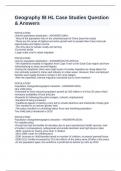Geography IB HL Case Studies Question
& Answers
POPULATION
Uneven population distribution - ANSWERCHINA:
- Most of the population lives in the urbanised part of China (near the coast)
-These are the areas of highest economic growth and so people there have more job
opportunities and higher income
-The only jobs for people rurally are farming
-Economic divide
-Large scale rural to urban migration
POPULATION
Uneven population distribution - ANSWERSOUTH AFRICA:
-The Apartheid resulted in migration from Cape Town to the South East region and from
Johannesburg to areas around Maputo
-During the Apartheid, there were high levels of circular migration as cheap labour for
men primarily existed in mines and industry in urban areas. However, their unemployed
families were legally bound to remain in the rural villages
-After the Apartheid, internal migration increased due to more freedom
POPULATION
Population change/demographic transition - ANSWERCHINA:
One child policy
-Estimated to have reduced population growth by 300 million in it's first 20 years which
increases availability of food and jobs
-Rewards for following the policy (wages, schools, employment)
-Standard of living increased
-Traditional appeal of wanting a boy led to unsafe abortions and infanticide of baby girls
-This resulted in an uneven gender ratio
-The policy resulted in a shrinking labour force and shrinking population
Two child policy introduced in 2016
POPULATION
Population change/demographic transition - ANSWERRUSSIA:
Pro natalist policy
-Russia has had low fertility for decades due to poor reproductive health services, lack
of modern contraceptives, widespread and unsafe abortions and high divorce rates
-1930: rewards for having more than 2 children
-1941-1990: taxes for childlessness
-2006: increase in child benefits based on number of children, increased parental leave
-2006-2011: fertility increased by 21% but effects of the policy wore off after a few years
-As the population ages, the workforce is predicted to decline by 15% by 2024
,POPULATION
Population change/demographic transition - ANSWERSINGAPORE:
-Anti natalist policies in 1972-1987 as a result of a large young population: access to
low cost contraception, easy to access family planning clinics, free education and
healthcare for small families, sterilisation programmes promoted and use of media to
promote smaller families
-Pro natalist policies in 1987 due to drastic population decline: maternity leave
increased and covered for first 4 children, child benefit increased and sterilisation and
abortion discouraged
-Successes: slight increase in fertility rate
-Limitations: changing people's minds about family size is difficult, some people saw
government measures as controlling, measures not always supported by businesses
who could not afford to have absent employees through maternity leave
POPULATION
Contemporary megacity - ANSWERSHANGHAI:
-Rapid growth: Shanghai was forced to open to trade by Western powers after the
Opium war of 1840 as it is a coastal town
-Positives of growth: increasing financial power, tourist destination, growing economy,
more job and housing opportunities
-Negatives of growth: competition with Hong Kong after firms moved their offices there
after the declaration of people's republic of China in 1949, jobless migrants, high levels
of air pollution, strained resources and increased house prices, which can lead to
homelessness
POPULATION
Forced movements - ANSWER3 GORGES DAM:
-Info: the 3 Gorges Dam is a hydroelectric gravity dam that spans the Yangtze river by
the town of Sandouping and is the largest power station in the world by capacity (to
meet China's increasing demand for electricity and water storage as the population
adopts a more Western culture)
-Advantages: reduces China's dependency on coal, protects 10 million from flooding,
thousands of jobs generated, provides energy to Shanghai
-Disadvantages: 1.2 million people moved to make space for the dam, dozens of towns
flooded, most of the land designated for resettlement is higher up and so cold and
infertile, mouth of river may be starved of silt, archaeological treasures drowned
POPULATION
Forced movements - ANSWERSYRIA:
-PUSH factors from Syria to Europe: fighting intensifying, economy and services
collapsed, not enough aid available, political instability
-PUSH factors from other countries (Lebanon, Jordan and Turkey): refugees not
allowed to work, not enough opportunities for Syrian children to be educated, countries
are not compensated which results in strain on resources
-PULL factors to Europe from Syria: safety, work prospects and education
, POPULATION
Ageing population - ANSWERJAPAN:
-Drastic change in population structure since 1945: decrease in birth rate and death rate
-27% of population are over 65
-Problems: inadequate labour force, trade deficit, migration of Japanese industry to
other countries, strain on working population
-Government options: raising taxes, increasing retirement age
POPULATION
Demographic dividend - ANSWERSOUTH KOREA:
-Aggressive population policy: invested in healthcare centres and family planning
-Fertility rate dropped 5.4 in 1950 to 1.2 in 2001
-97% of school age children attending school by 1990 compared to 54% having access
to education previously
-Escaped the weak fishing economy of the 1950's by improving relations with Japan,
increasing investment capital and therefore strengthening the economy
-Construction programmes to improve infrastructure and provide jobs
POPULATION
Anti-trafficking - ANSWERIOM INDONESIA:
-Issue: majority of women are trafficked through recruitment channels for labour or
sexual exploitation
-IOM: awareness raising and improved monitoring of the recruitment market, protection
of victims through victim assistance, strengthening of an effective criminal justice
response
-Return, recovery and reintegration assistance- physical/mental health care, temporary
shelter, family counselling, legal aid
-Detailed database of every victim helped since 2005 provides a unique source of
information for policy-makers and service providers to better understand the trends of
human trafficking in Indonesia
POPULATION
Anti-trafficking - ANSWERURBAN LIGHT THAILAND:
-Empowering at risk males through medical checkups, houses for homeless teenagers
etc to protect from sex trafficking
POPULATION
Gender equality policies - ANSWERETHIOPIA:
-Issue: women didn't have any rights to land or property
-Solution: Gender Action Plan provides women with a land certificate and space was
made for 2 people to register joint ownership
-Evaluation: the GAP has given wives, widows and divorcees new rights, status and
confidence. However, traditional men and women roles remain and there is still some
conflict over land




